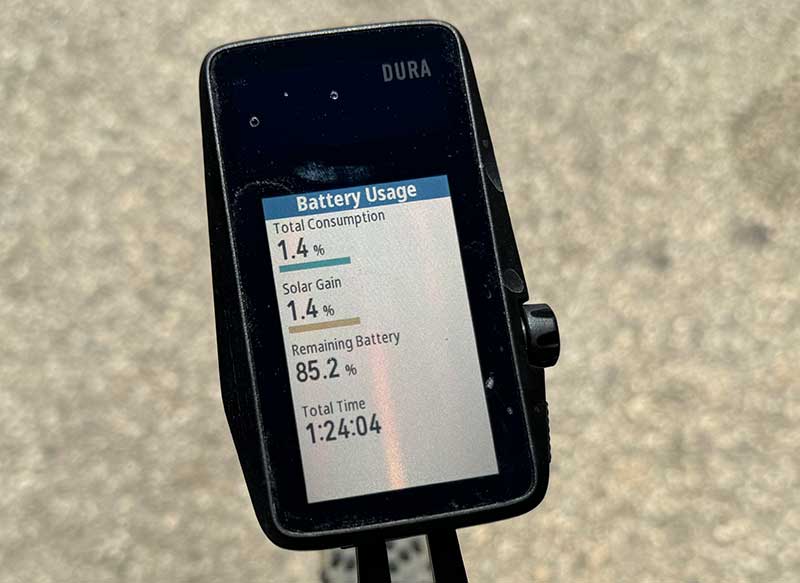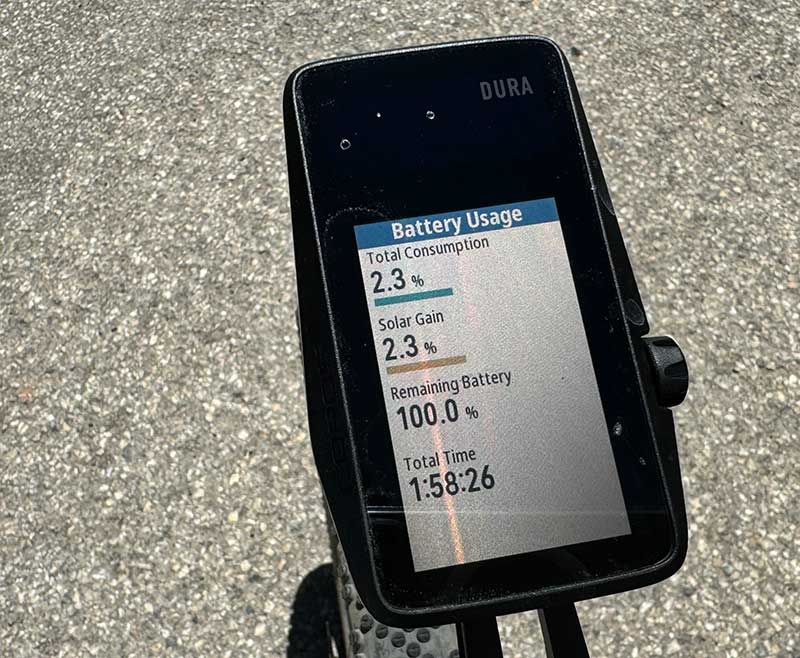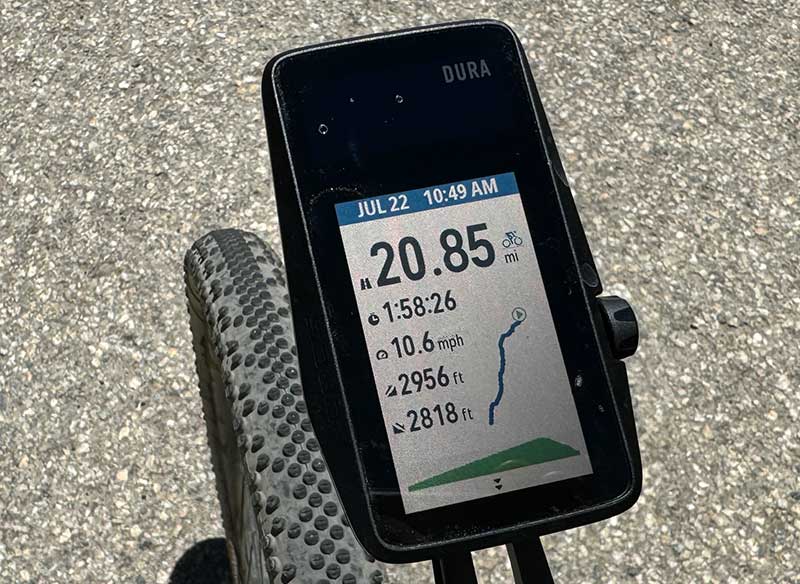Originally published at: Coros Dura, Inflation Beater - Slowtwitch News
The Coros Dura and I have gotten to know each other over the last 6 weeks. Coros did the opposite of Wahoo, which started with a GPS head unit and went to the watch. Coros is already a fixture in GPS watches. Users include Eliud Kipchoge, Jakob Ingebrigtsen, Eilish McColgan, Alex Yee, Emma Coburn and Kilian Jornet (look at his just-completed Alpine Connections). It has now gone the other way and released a bicycle GPS head unit.
The Dura is worth your knowing about for 2 reasons beyond any others: first, the Dura costs $249; second, battery life. That $249 is really inexpensive when you consider the 2.7” screen size is the same as Wahoo ROAM’s screen. Wahoo’s BOLT has a 2.2” screen and at $279 is in the same price region as the Dura.

As to battery life it’s claimed at 120 hours to a charge and I don’t really know if that’s accurate because I have not been very successful at running this battery down. Over the past weeks I’ve been riding with the Dura it’s been very sunny and not shaded and the darned thing keeps recharging because of the solar panel built into the unit. Note the image above. An almost-90 minute ride chewing up zero battery. Further below you’ll see a 2 hour ride, same thing. So, I don’t know that “battery life” is an applicable metric any longer. Maybe a new metric is needed like “recharge cycle” or “power scheme.” It’s like the thing has an alternator. You can see how compelling that might be.
This is a very new product and if you’ve been following DCRainmaker’s comments (he’s been all over the Dura) you can see that this company has had a few false starts, both with hardware and software. Let’s tackle the hardware first, both the way this product works and why it’s had a spotty start (and how to maximize your experience if you think you’re a candidate for a Dura).

If you’re a Coros watch user you’ll find that the Dura uses a similar motif, in that there are 2 buttons and 1 of those buttons is a scroll wheel that is also a button. Imagine a Wahoo for example, where you have up and down buttons that cycle you through a list of menu options. You do that here with a scroll wheel and when you turn that wheel to your chosen option you then push the wheel, like a button, to select it. The other button is the back button (same thing for both the watch and the head unit). The head unit’s face is also a touch screen which is also scrollable (so you have 2 ways to scroll). As you see, the screen is color and also backlit.
You mount this unit using the same quarter turn motif as a Garmin and that’s handy If you have more than one head unit and you don’t need to keep changing the mounts. Now, as to that hardware hiccup: There was an issue with the tabs breaking on the unit itself, but only with arcane and off-brand mounts. The Dura reportedly worked fine on standard quarter-turn mounts as well as popular accessory brands like K-edge, and it worked fine on my Zipp Quickview (The Dura is mounted on my Quickview in these images). New units shipping later this month will have something I wish all head units had: the tabs are replaceable (with 2 screws), so a broken tab on the Dura no longer means you trash the whole device. Kind of like replaceable derailleur hangers on bike frames. The enterprising customer takes possession of his Dura in about 2 weeks from this writing, when the units with replaceable mounts will begin to ship.
Software: Every function I want and that I use – data and navigation – is available with the Dura with certain exceptions which I’ll list in a minute. Coros has a web interface you can log into and there’s a bunch of performance software there. For the purpose of configuring your Dura I use the Coros app and it’s pretty similar to the ELEMNT app I’d use for my Wahoo devices.

I won’t go into a step-by-step process for how to configure the Dura but I found it pretty easy to set up the pages I want – data and navigation – and all of my sensors were supported, including my Garmin Varia radar. Just enabled is the ability for Shimano and SRAM controls – what SRAM calls its bonus button on the shifter hood – to toggle pages on the Dura but I have not yet tested this. Map navigation of routes was fine and the Dura didn’t break a sweat as I downloaded several maps that total the United States. Which took maybe 2 minutes. There appears to be enough hard drive space to hold pretty much all the maps of all the places you’d want to ride.
I will now list the things I would like to see that I don’t yet see, with an estimated delivery time.
If you’re a STRAVA segment hunter that’s a necessary page on your head unit. The Dura is not there yet, but that is apparently imminent. You would invest in your Dura and then wait for a firmware patch that gives you that. Maybe 1 to 3 months out.
Integration with RideWithGPS. I like to build my routes in RWGPS and then I sync them down to my (let’s say) Wahoo ROAM. There are 2 ways to handshake with 3rd party integrations with the DURA and one is to select the integration from a long list of participants you’ll find in the Coros app. RWGPS is not one of those. But if you go in through RWPGS and choose a hardware maker to sync to, you’ll see Coros appearing and you make your integration that way. That has been possible except that a few days ago the integration broke. Since it did work I can assume fixing what broke will take days or a very few weeks again allowing you to sync down routes to the Dura from RWPGS. (Maybe it’s already been fixed.)

If you want a proper climbing page, which has a silhouette of what you did just climb and what it is that’s in front of you to climb, I don’t believe this is here yet on the Dura but it is promised and coming.
Finally let’s talk about “route to start” and “rerouting.” This of course being part of the navigation suite. These are really, really hard tasks to get a bike computer to perform. When these tasks are needed the Dura needs your handheld to perform that task. The Dura queries your iPhone (let’s say), the iPhone does your rerouting, sends the answer to the Dura, which patches it into your navigation. This works pretty seamlessly to you except when your handheld has no connectivity. The only problem is when you don’t have cell connectivity, or you don’t take a handheld with a GPS with you when you ride.
I’ve been out there riding with a head unit costing 40 or 50 percent less money than the others I own and other than the STRAVA segments thing – which I have to wait for – I don’t feel that I’m out there with a lesser device. Let us take a moment to consider the Dura… that done, we can now return to our regularly scheduled inflation woes.